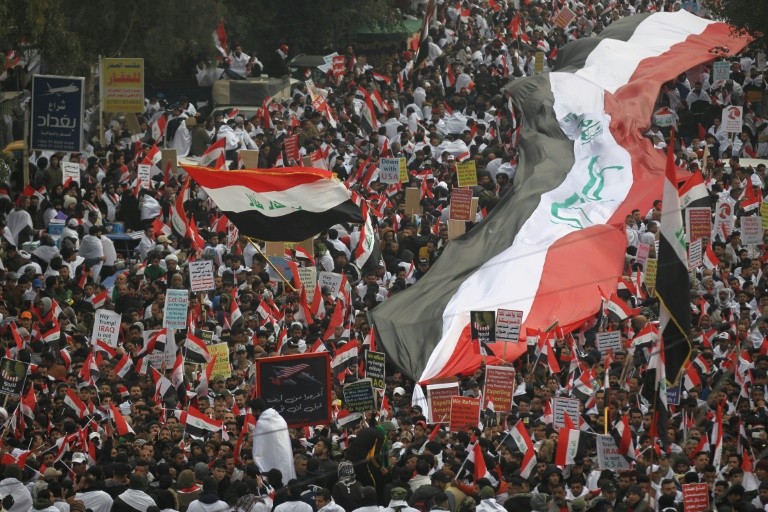Thousands of supporters of populist Iraqi cleric Moqtada Sadr gathered in Baghdad on Friday for a rally to demand the ouster of US troops, putting the protest-hit capital on edge.
The march rattled the separate, months-old protest movement that has gripped the capital and Shiite-majority south since October, demanding a government overhaul, early elections and more accountability.
Thousands of men, women and children massed under grey skies in the Jadiriyah district of east Baghdad, chanting “Get out, get out, occupier!”
Some waved signs in Arabic and English reading “Death to America” and one protester carried a cardboard cut-out of US President Donald Trump on the gallows.
A representative of Sadr took to the stage at the protest site and read out a statement by the influential Shiite cleric and populist politician.
It called for all foreign forces to leave Iraq, the cancellation of Iraq’s security agreements with the United States, the closure of Iraqi airspace to US military and surveillance aircraft and for Trump not to be “arrogant” when addressing Iraqi officials.
“If all this is implemented, we will deal with it as a non-occupying country — otherwise it will be considered a country hostile to Iraq,” the statement said.
About two hours into the rally, protesters began peeling away from the square but thousands lingered.
 AFP/File / Ayman HENNAUS-led operations against the Islamic Strate group have been on hold after Iran carried out retaliatory missile strikes against Iraqi bases housing coalition troops
AFP/File / Ayman HENNAUS-led operations against the Islamic Strate group have been on hold after Iran carried out retaliatory missile strikes against Iraqi bases housing coalition troopsAmerica’s military presence has been a hot-button issue in Iraq since a US strike killed Iranian general Qasem Soleimani and a top Iraqi commander outside Baghdad airport on January 3.
Around 5,200 US troops are in Iraq to lead a global coalition in fighting the Islamic State group, but Iraq said the strike against Soleimani violated that mandate.
Joint US-Iraqi operations were paused and outraged parliamentarians voted for all foreign forces to leave.
Baghdad said it wanted to discuss a timeline for departure but US special envoy for the anti-IS coalition, James Jeffrey, said Thursday there was no “real engagement”.
– ‘Million-strong’ march –
Long opposed to the US troop presence, Sadr seized on the public anger over the drone strike to call “a million-strong, peaceful, unified demonstration to condemn the American presence and its violations”.
Pro-Iran factions from the Hashed al-Shaabi paramilitary force, usually rivals of Sadr, agreed to join.
Qais al-Khazali, a Hashed commander once mentored by Sadr but now counted among his top competitors, endorsed the rally.
“To Trump, the fool — the people’s message of rejection was clear: if you don’t leave voluntarily, you’ll be ousted despite yourself,” he tweeted.
Iraq’s top Shiite authority, Grand Ayatollah Ali Sistani, did not explicitly back the rally in his weekly sermon on Friday but said Iraqis had a right to protest “peacefully” in support of their country’s sovereignty.
The sermon, read by a representative, said parties were “very late” in forming a new government to replace the cabinet of premier Adel Abdel Mahdi.
Read Also: Why Coca-Cola Refuses To Ban Plastic Bottles
Abdel Mahdi has acted in a caretaker role since resigning in December, as the anti-governments protests reached a fever pitch.
They were soon overshadowed by spiralling US-Iran tensions and protesters had feared being totally eclipsed by Sadr’s rival rally.
 AFP/File / Haidar HAMDANISupporters of Sadr rally near his residence in the Shiite shrine city of Najaf last month
AFP/File / Haidar HAMDANISupporters of Sadr rally near his residence in the Shiite shrine city of Najaf last monthThere had been worries Sadr’s supporters might attack anti-regime protest camps in Baghdad’s Tahrir Square, the presidential palace or the high-security Green Zone, home to the US embassy and other foreign missions.
The move would not be without precedent for Sadr, who urged followers to storm the Green Zone in 2016 in a challenge to the government over undelivered reforms.
But there were no attempts on Friday morning to breach government zones or head to Tahrir.
– Sadr hedges bets-
Sadr, 46, battled US forces at the head of his Mehdi Army militia after the 2003 US-led invasion but is a fickle politician, notorious for switching alliances quickly.
He backed anti-government protests when they erupted in October — but also controls parliament’s largest bloc and his followers hold top ministerial positions.
His spokesman Saleh al-Obeidy hinted that while others unequivocally blamed either the United States or Iran for Iraq’s instability, Sadr would choose a middle path.
“We believe that both are behind this ruin, and Sadr is trying to balance between the two,” he said.
 AFP/File / –Long opposed to the US troop presence in Iraq, Sadr called for ‘a million-strong, peaceful, unified demonstration to condemn the American presence and its violations’
AFP/File / –Long opposed to the US troop presence in Iraq, Sadr called for ‘a million-strong, peaceful, unified demonstration to condemn the American presence and its violations’Harith Hasan of the Carnegie Middle East Center said Sadr was trying to sustain his “multiple identities”.
“On the one hand, (he seeks to) position himself as the leader of a reform movement, as a populist, as anti-establishment,” Hasan told AFP.
“On the other hand, he also wants to sustain his image as the leader of the resistance to the ‘American occupation’,” partly to win favour with Iran.
AFP

